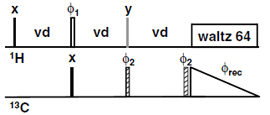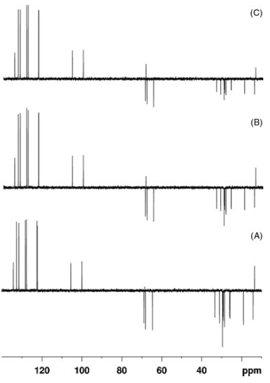NMR Methodology
(J. Furrer)
a) HMBC Experiments |
b) 1D ROESY |
c) DEPT |
c) DEPT
Multiplicity-dependent 1D 13C-NMR experiments such as DEPT still belong to the most common experiments for assigning 13C signals and for the elucidation of molecular structures on a routine level. However, many scientists often overlook the fact that the effectiveness of polarization transfer is directly influenced by the magnitude of the 1JCH coupling constant value during the precession periods. For a given molecular system containing different chemical functionalities with different 1JCH coupling constants, the proper choice of the duration of a fixed delay, D, which is inversely related to 1JCH, may be challenging if the range of 1JCH is large. Incomplete polarization transfer cannot be avoided in such cases, and maximum polarization transfer cannot be achieved for all CH fragments simultaneously because D is in general chosen using a single, average, 1JCH coupling value, typically 145 Hz. we have proposed a modified DEPT experiment, ACCORDEPT, which intends to overcome this deficiency of the standard DEPT experiment. To this end, the application of the accordion method to uniform the response intensity over wide ranges of coupling constants has been implemented in the 1D DEPT experiment.
-> image 1
Pulse sequence for the ACCORDEPT experiment incorporating the accordion delays, labeled vd, derived from a standard DEPT pulse sequence. These delays can be decremented or incremented from a value of 1Jmin (inverse of twice the smallest 1JCH coupling) to
1Jmax (inverse of twice the largest 1JCH coupling), or set as a random list.
-> image 2
DEPT135 and ACCORDEPT135 spectra of molecule 1 dissolved in CD2Cl2. (A) DEPT135 optimized for a 1JCH coupling constant of 145 Hz. (B) ACCORDEPT135 recorded using the DCT method. (C) ACCORDEPT135 recorded using the DCC method. For both ACCORDEPT, the range of 1JCH coupling constants sampled is 120–260 Hz. It has been sampled using 32 values equally spaced in time or frequency.



